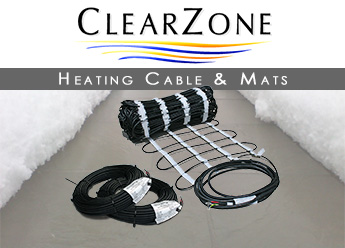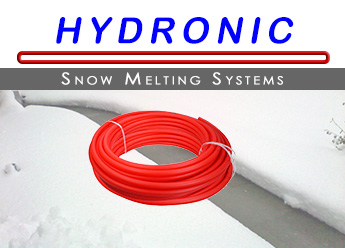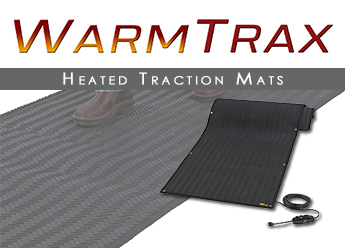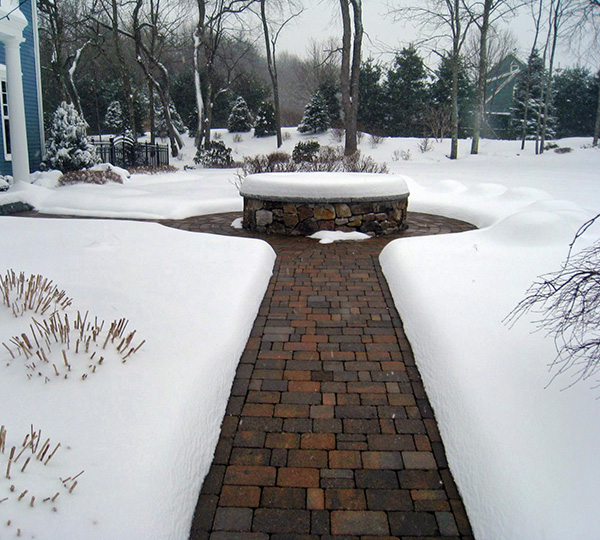Keeping walkways and sidewalks clear of snow during the winter months can be a challenge. But maintaining clear walkways and paths is not only a good safety practice, most city ordinances require home and business owners to keep sidewalks clear after snowstorms. For most of us, that means breaking out the snow shovel and salt. But bear this in mind: there is a better option.
Installing an automated radiant snow melting system is the ideal way to keep passageways safe during winter storms. Snow melting systems detect weather conditions and begin heating walkways as the first snowflake hits. The warm sidewalk melts the snow and prevents it from accumulating. The systems are easy to customize to meet your specific needs, including flexibility when it comes to your budget. Warmzone’s industry-leading snow melting systems can be installed in concrete, asphalt, and under pavers. For more details, and information about Warmzone’s professional system design services, call Warmzone® today at 888-488-9276.

Electric Radiant Snow Melting Cable and Mats
ClearZone™ electric heating cable and cable pre-spaced in mats are proven industry leaders for heating sidewalks, pathways, ramps, driveways, and more. The snow melting cable can be installed in virtually any custom configuration or application, and the snow melting mats simplify installations by providing proper cable spacing in easy-to-roll-out mats.
Read more
Water-based Snow Melting Systems
Hydronic snow melting systems are generally designed for installation in large snow melting applications because of their potential for lower operating costs. A boiler heats specially treated water that is pumped through the closed loop of PEX tubing installed under in the walkway, heating the area and preventing snow and ice from forming.
Read more
An Affordable Alternative for Heating Walkways
Some shaded passageways around the home are perennially covered in snow or ice during the winter months. This can make some areas difficult to navigate, especially for the elderly. One affordable option for keeping sidewalks and narrow walkways clear of snow is to use WarmTrax® portable heated traction mats.
Read more

The key to having an efficient, reliable radiant snow melting system is to make sure it is designed and installed correctly. Knowing the importance of proper installation, Warmzone staffs an expert design team that evaluates your specific needs, location, and budget to design the ideal system for your home. In addition to Warmzone's industry-leading products and system components, your system will be designed according to ASHRAE standards for optimum functionality. We've been doing this for a long time, and we'll put our many years of expertise to work for you to make the best system for your home or business. We'll make sure that your system utilizes all the right components and is laid out for maximum effectiveness and energy-efficient operation. Each system design contains all the necessary information for your electrician, including the proper layout and materials, proper load calculations, breaker sizes, number of breakers, etc.
Hydronic snow melting systems can also be installed to heat walkways, but installation is considerably more complex when compared with electric systems. However, for large areas, because hydronic systems can utilize natural gas or fossil fuels, they have the potential to offer lower operating costs. For this reason, hydronic systems are considered for large snow melting applications. However, the performance and relatively easy installation make electric radiant heat snow melting systems a popular choice for homeowners.
Warmzone systems are fully automated and maintenance free, so once it's installed, there's not much need to give it any thought. But what does it take to install a radiant snow melting system? Can a do-it-yourself homeowner do some of the work to keep installation costs down?
Installing a snow melting system to heat your sidewalks and walkways is relatively easy, and much of the prep and cable layout can be completed by the homeowner. However, it is vital to understand that a qualified electrician wire the system in order to keep the warranty valid. Also, it's important to know the do's and don'ts when it comes to installing a snow melting system.
Once the frame and remesh have been installed (for a concrete sidewalk), the heating cable is laid out over the area to be heated. To heat paver walks, embedd the heat cable in the paver sand. Apply another layer of dust and then place the pavers on top. Radiant heat can also be installed in mortar for paver walkways. (Always refer to your layout provided by Warmzone.) Make sure the cable is properly spaced. (Do not allow the cable to overlap or be less than 3-inches apart. The cable in mats is already pre-spaced, but be careful to avoid placing the mats too close to each other. Three-inch spacing must always be maintained.
Using zip ties, secure the heat cable to the remesh (or rebar). If handrails are being installed, make sure that pre-sleeves have been installed in order to avoid drilling after the concrete pour. Use Mesh-Up® support chairs to keep the remesh and heat cable elevated off the ground. The cable should be about 2 or 3-inches from the surface of the sidewalk. Next, the concrete can be poured. NOTE: Be careful to avoid damaging the cable with shovels! For more information about our snow melting systems and customer services, please call us today at 888-488-9276.